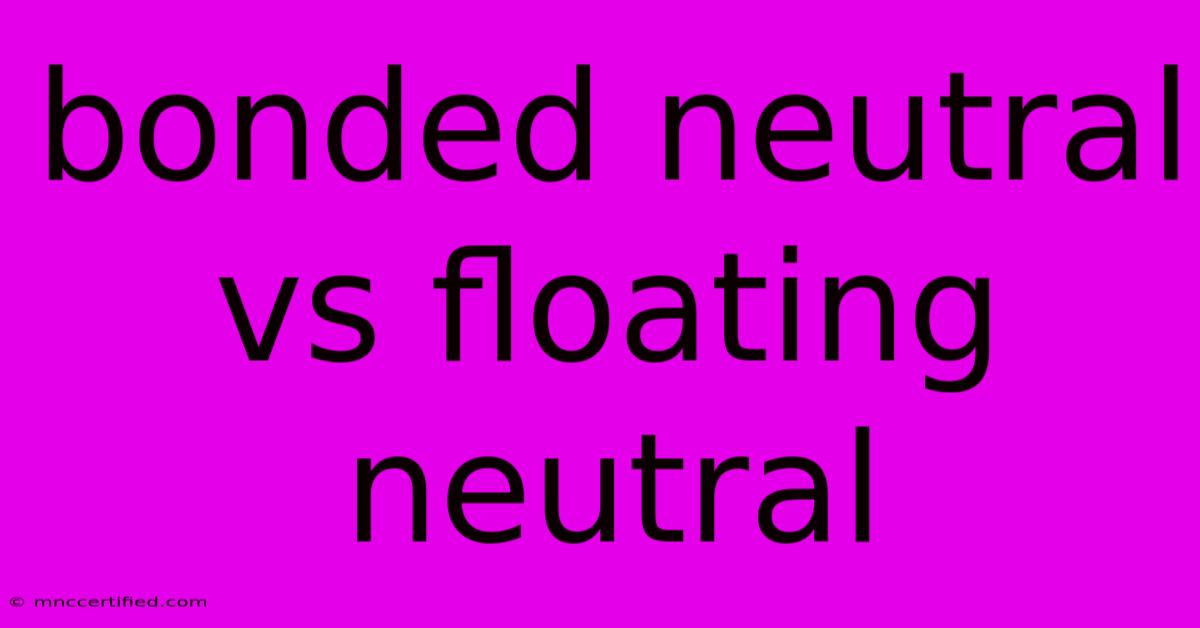Bonded Neutral Vs Floating Neutral

Table of Contents
Bonded vs Floating Neutral: Understanding the Difference in Electrical Systems
In the world of electrical wiring, understanding the nuances of neutral wiring is crucial for ensuring safety and proper functionality. Two primary methods of neutral wiring, bonded neutral and floating neutral, each have distinct characteristics and applications. This article delves into the differences between these two systems, explaining their principles, advantages, and potential risks.
Bonded Neutral: The Grounded Connection
In a bonded neutral system, the neutral conductor is directly connected to the ground at the main service panel. This connection creates a low-impedance path for fault currents, ensuring that any electrical fault will be quickly directed to ground, minimizing the risk of electrical shock or equipment damage.
Advantages of Bonded Neutral:
- Enhanced Safety: The direct connection to ground provides a low-resistance path for fault currents, minimizing the potential for electrical shock and fire hazards.
- Improved Fault Detection: Ground fault circuit interrupters (GFCIs) rely on a bonded neutral system to effectively detect and interrupt ground faults.
- Increased Reliability: By ensuring a stable ground reference, a bonded neutral system enhances the reliability and performance of electrical equipment.
Disadvantages of Bonded Neutral:
- Potential for Ground Loops: In certain scenarios, a bonded neutral can introduce ground loops, which may cause unwanted currents to flow through unintended paths, potentially affecting equipment performance.
- Increased Risk of Shock in Some Cases: In specific situations, a bonded neutral may increase the risk of shock if the ground wire is accidentally disconnected or damaged.
Floating Neutral: No Ground Connection
In a floating neutral system, the neutral conductor is not directly connected to the ground. This means that the neutral wire does not have a direct path to ground, and fault currents may flow through different paths, potentially resulting in higher voltages or unexpected behavior.
Advantages of Floating Neutral:
- Reduced Risk of Ground Loops: By avoiding a direct ground connection, a floating neutral system helps minimize the risk of ground loops, improving electrical system stability.
- Increased Fault Tolerance: In some cases, a floating neutral system may offer better fault tolerance, as faults can be isolated more easily.
Disadvantages of Floating Neutral:
- Increased Risk of Shock: Without a direct ground connection, a floating neutral system increases the risk of electrical shock in the event of a fault, as fault currents may flow through unintended paths, including humans.
- Less Effective Fault Detection: GFCIs rely on a bonded neutral system to function correctly; therefore, they are less effective in a floating neutral system.
- Potential for Higher Voltages: The lack of a ground reference in a floating neutral system can lead to higher voltage variations, potentially affecting equipment performance.
Choosing the Right System
The choice between bonded neutral and floating neutral depends on various factors, including the specific application, local electrical codes, and the potential risks associated with each system.
- Bonded neutral systems are typically preferred in residential and commercial applications, as they provide a higher level of safety and are compatible with GFCIs.
- Floating neutral systems are often used in specific industrial or specialized applications where ground loops or other factors necessitate a different approach.
Understanding the advantages and disadvantages of each system is crucial for making informed decisions regarding the safety and functionality of your electrical installation. If you have any doubts or concerns, always consult a qualified electrician for expert advice.

Thank you for visiting our website wich cover about Bonded Neutral Vs Floating Neutral. We hope the information provided has been useful to you. Feel free to contact us if you have any questions or need further assistance. See you next time and dont miss to bookmark.
Featured Posts
-
Argentina Player Ratings Messi Dimmed Vs Paraguay
Nov 15, 2024
-
Paraguay Holds Messi Argentina Player Ratings
Nov 15, 2024
-
Sno Bond Christmas Tree Snow Flock
Nov 15, 2024
-
Vortex Bonded Leather Gaming Chair
Nov 15, 2024
-
Wordle 1245 Fridays Answer Hints Clues
Nov 15, 2024